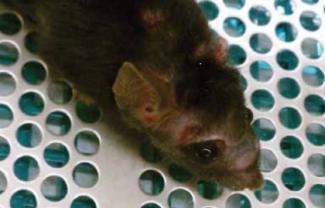Fur mites are an ectoparasite from the class Arachnida (which also includes spiders, scorpions, and ticks) that affect wild and laboratory rodents alike. Unfortunately, even in laboratory settings, infestation can be common, with imports being the most probable source.1,2 There are numerous publications regarding the detection, control, and treatment of fur mites; unfortunately, the conclusions from these sources vary widely.
Mice and rats each have species of fur mites than can infect them. Either it is less reported or just less studied, but there is little literature specifically addressing the fur mites of rats (Radfordia ensifera and Radfordia affinis). It is important to note that these mites can cross species (mice mites can survive on rats and vice versa). The rest of this article is written in reference to mites and mice, but understand that the information pertains also to rats and their mites.
Obligate parasites, mites have a direct life cycle that includes egg, larvae, nymph, and adult life stages. Eggs attach permanently to hair shafts of an infected animal and hatch within 5 to 7 days. There are two main species of mouse fur mites: Myobia musculi and Mycoptes musculinus.
The complete egg to adult life cycle occurs in about 23 days. Adults are able to produce fertile eggs within 24 hours.3,4 The lifespan of the adult mite is not widely published. As adults, mites are still very small, about 250 μm.
Direct transmission or transmission through soiled bedding is believed to be the most common methods. Only mice with hair can be infested with mites, thus this is one problem nude rodents are immune to. Pups are usually infected 4 to 5 days after birth (shortly after they begin to grow hair). With infestations being fairly common, the effects of mites on research animals can be significant. Many mice show no outward signs of infection at all. Others exhibit obvious skin changes, including pruritus (itching), scruffiness, ulcerative dermatitis secondary to bacterial infection of self-traumatized skin, or damage to the eyes or ears due to selfmutilation
Often these complications become so severe that the mouse needs to be euthanized (resulting in a complete loss of data). Detected or not, fur mites cause other physiologic changes that can affect research. Chronic inflammation, decreased lifespan, decreased body weight, immune responses, fibrosis, decreased fertility, and hyperkeratosis are examples.1, 2, 5
Part of the problem of controlling fur mites is that detection is not always easy. Parasite burden (the number of mites on an individual animal), length of infestation, and age of the mouse all influence the ability of any given test to successfully detect the presence of fur mites. There are three main testing methods: direct sampling, examination of the pelt, and polymerase chain reaction (PCR). Direct sampling involves collecting hair and skin by plucking, scraping, or taping and examining under a microscope. M. musculi and M. musculinus are reported to prefer to live on different areas of the mouse; therefore, more than one area per mouse must be sampled. This is the most versatile method, and is best for sampling large numbers. The three downsides to this methods are that 1) the extra handling can be stressful 2) it is very time/labor intensive (and thus costly) and 3) it relies on highly skilled testers. Even the most competent staff member is at risk of mental fatigue during sampling and reading of slides, especially in large numbers.
The second method of testing is pelt collection and examination. Because this requires sacrifice of the animal, this is done as a small sample of the colony, or most often, during sentinel processing.
Again, this method requires highly trained personnel at their best. The reliability of this testing method is perhaps most questionable.6,7
The final, and newest method, is PCR testing. Basically, this test identifies DNA of fur mites that are on the mice or the cage. The advantages of this test are that it is fast and easy to perform. Because samples must be sent to a reference lab (off-site), it has the disadvantages of delayed result reporting and high cost. When outbreak occurs, treatment is decided by the veterinarian and investigator. Together, they must determine what course of treatment will be most efficacious and least detrimental to the study. Generally, the options include topical or oral medications and treated bedding. When treating any parasite, treatment is necessarily lengthy and/or requires repetition in order to completely eliminate the parasite in its varying life cycles and reproduction.
At our facility, we use many measures to control and eradicate fur mites. Our regular sentinel processing includes dirty bedding exposure and pelt examination. The veterinary staff tests suspect dermatitis cases through direct sampling. We test, and now treat, all animals coming in through quarantine. Investigative staff can assist on their part by following good hygiene and biosafety techniques both within the facilities and in their own labs. Further, be aware that wild populations of rodents in both places can be vectors of parasites. In a perfect world, our animals and studies would be absolutely free of influences of fur mites; the reality is that it is a complicated problem that requires multiple levels of cooperation and vigilance.

